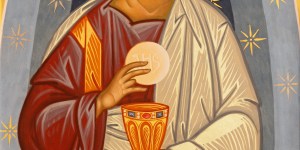Lenten Campaign 2025
This content is free of charge, as are all our articles.
Support us with a donation that is tax-deductible and enable us to continue to reach millions of readers.
Catholic Churches today feature a large box called a tabernacle, where consecrated hosts are kept after Mass.
This custom took many centuries to be established, as early Christians did not have their own permanent churches. Instead, they were constantly on the move, celebrating Mass in people's homes or in hiding.
Consequently, it should come as no surprise that there were no fixed tabernacles to house consecrated hosts, but only portable boxes.
James Monti, in the book published by Our Sunday Visitor called In the Presence of Our Lord, notes this early custom.
This was a way for Christians to protect the Eucharist from desecration by the pagans of Rome, and also to provide the Blessed Sacrament to the sick and homebound.
The Catholic Encyclopedia further confirms this early practice, and recounts one of the first Eucharistic miracles that occurred in the Church's history.
Eventually, when Christians were able to build permanent structures for the liturgy, they also created different kinds of tabernacles to house the consecrated hosts.
This shows that even from the very beginning, Christians knew that this "bread" was different and was the very presence of God.










